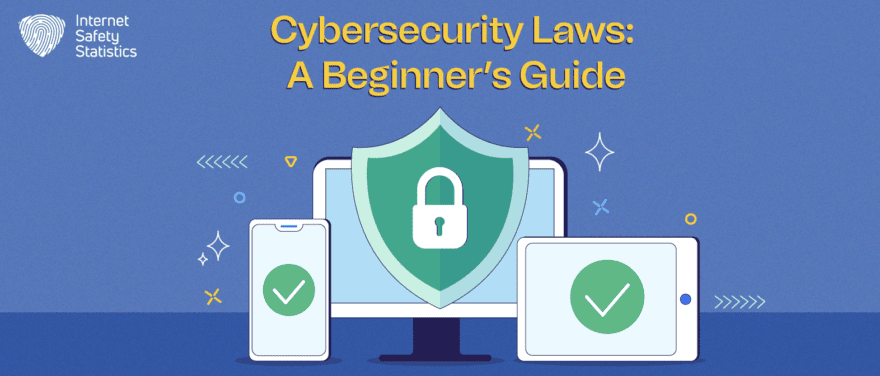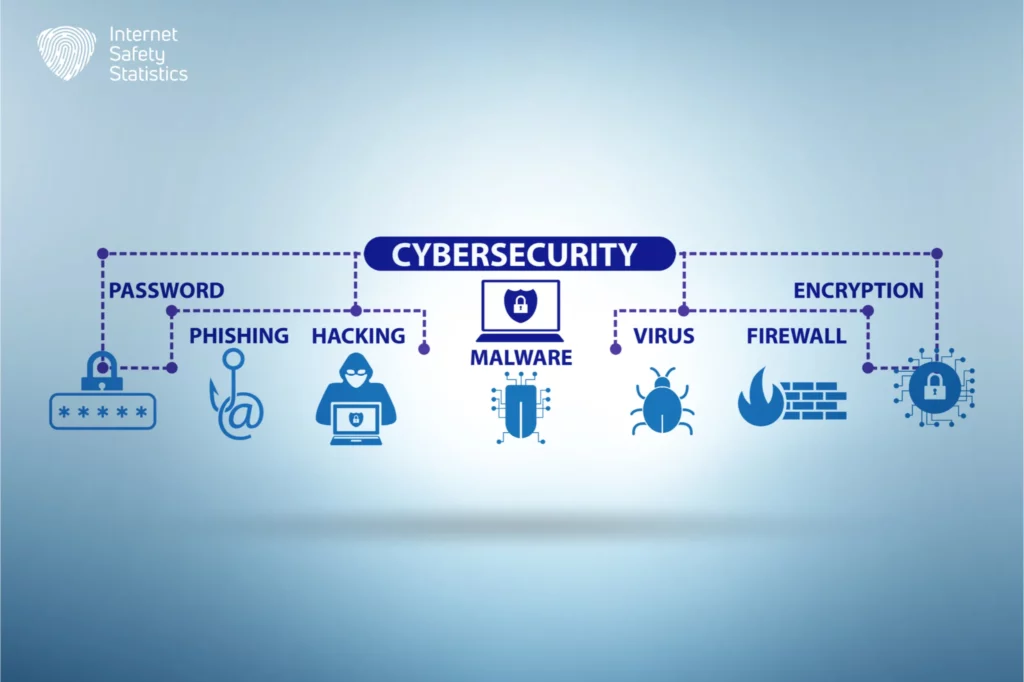
Cybersecurity laws are a set of rules and regulations that aim to protect the security and privacy of individuals, organisations, and nations in the online environment. Cybersecurity laws are important because they help to prevent, detect, and respond to cyberattacks that can cause significant harm to the victims and undermine the trust and stability of the digital world.
What are Cybersecurity Laws?

Cybersecurity laws, also known as information security laws or data protection laws, are a set of regulations and legal frameworks established by governments and organisations to safeguard digital information, computer systems, networks, and the overall cyber environment. These laws are designed to achieve several essential purposes:
- Protection of Sensitive Data: Cybersecurity laws protect sensitive and confidential information, including personal data, financial records, and intellectual property, from unauthorised access, theft, or breaches.
- Prevention of Cybercrime: They serve as a deterrent to cybercriminal activities such as hacking, identity theft, malware distribution, and other malicious acts by imposing legal consequences for offenders.
- Data Privacy: Many cybersecurity laws incorporate provisions related to data privacy, ensuring that individuals’ personal information is collected, processed, and stored securely and with their consent.
- National Security: In some cases, these laws have national security implications, as they help defend critical infrastructure, government systems, and defence-related information from cyberattacks and espionage.
- Consumer Trust: By enforcing cybersecurity standards, these laws enhance consumer trust in digital services and e-commerce platforms, fostering a safer online environment.
Necessity of Cybersecurity Laws in the Digital Age:
The digital age has ushered in unprecedented technological advancements and connectivity, but it has also exposed vulnerabilities that necessitate the existence of cybersecurity laws:
- Proliferation of Cyber Threats: The digital age has witnessed a surge in cyber threats, ranging from data breaches to ransomware attacks. These threats can disrupt businesses, compromise individuals’ privacy, and lead to substantial financial losses.
- Global Interconnectedness: The interconnected nature of the internet means that cyberattacks can originate from anywhere and affect organisations and individuals worldwide. Cybersecurity laws provide a legal framework for international cooperation in combating cybercrime.
- Data Proliferation: The digital age has seen an exponential increase in the volume of data generated and stored online. Cybersecurity laws help regulate the handling of this data, ensuring it is managed responsibly and securely.
- Protection of Critical Infrastructure: Vital systems such as energy grids, healthcare facilities, and financial institutions rely heavily on digital technology. Cybersecurity laws are essential to protect these critical infrastructures from potential cyber threats that could have devastating consequences.
- Individual Rights: As individuals increasingly conduct their personal and professional lives online, cybersecurity laws protect their rights to privacy and the security of their data.
Key Cybersecurity Legislation Worldwide
Cybersecurity laws differ according to geographic regions.
1. General Data Protection Regulation (GDPR) – Europe:
GDPR is a comprehensive data protection regulation that applies to all European Union (EU) member states. Its key provisions include:
- Consent: Organisations must obtain clear and explicit consent for data processing.
- Data Subject Rights: Individuals can access, correct, and delete their data.
- Data Breach Notification: Organisations must report data breaches within 72 hours.
GDPR aims to protect EU citizens’ privacy and data rights, harmonise data protection laws across the EU, and encourage businesses to handle personal data responsibly.
2. California Consumer Privacy Act (CCPA) – United States:
CCPA is a state-level privacy law in California. Its key provisions include:
- Right to Know: Consumers can request information on the data collected about them.
- Right to Delete: Consumers can request the deletion of their personal information.
- Opt-Out: Consumers can opt out of the sale of their personal information.
CCPA is designed to enhance the privacy rights of California residents, giving them more control over their personal data and requiring businesses to be transparent about their data practices.
3. Personal Information Protection Law (PIPL) – China:
PIPL is China’s comprehensive data protection law. Key provisions include:
- Cross-Border Data Transfer Restrictions: Data can only be transferred abroad under specific conditions.
- Consent: Organisations must obtain clear and informed consent for data processing.
- Data Subject Rights: Individuals have the right to access, correct, and delete their data.
PIPL aims to protect the personal information of Chinese citizens, regulate the cross-border transfer of data, and ensure that organisations handle data responsibly.
4. Data Protection Act 2018 – United Kingdom:
This UK law supplements the GDPR. Key provisions include:
- Special Categories of Data: It addresses the processing of sensitive data categories.
- Law Enforcement Processing: It provides rules for processing personal data for law enforcement purposes.
The Data Protection Act 2018 aligns the UK with GDPR post-Brexit while addressing specific national considerations, ensuring data protection and privacy for UK citizens.
5. Personal Data Protection Bill – India:
This bill is currently under consideration in India. Key provisions proposed include:
- Consent: Organisations must obtain clear and informed consent for data processing.
- Data Localisation: Certain categories of data must be stored and processed in India.
- Data Subject Rights: Individuals can access and correct their data.
The bill aims to regulate the processing of personal data in India, protect individual privacy, and establish a framework for data localisation.
Cybersecurity Regulations by Industry
Each industry faces different challenges when it comes to online safety and privacy. That’s why cybersecurity laws are so important in an age where we rely heavily on online sources for information.
1. Healthcare Industry:
Healthcare organisations handle sensitive patient data, making them prime targets for cyberattacks. The challenges include protecting electronic health records (EHRs) and medical devices and maintaining patient confidentiality.
- Regulations: In the United States, the Health Insurance Portability and Accountability Act (HIPAA) enforces strict standards for the protection of patient health information (PHI). HIPAA mandates security controls, data encryption, and regular risk assessments to safeguard patient data.
2. Finance Industry:
The financial sector faces constant threats of financial fraud, identity theft, and data breaches. Financial institutions store vast amounts of valuable financial data, which makes them lucrative targets.
- Regulations: Regulations such as the Gramm-Leach-Bliley Act (GLBA) and the Payment Card Industry Data Security Standard (PCI DSS) in the U.S. require financial institutions to implement robust security measures. GLBA mandates protecting customers’ personal financial information, while PCI DSS focuses on securing credit card data.
3. E-commerce Industry:
E-commerce platforms handle a massive volume of transactions and customer data. Their unique challenges include ensuring secure online transactions, safeguarding customer payment information, and protecting against fraud.
- Regulations: While e-commerce doesn’t have industry-specific regulations like healthcare or finance, it must comply with general data protection laws like GDPR or CCPA when handling customer data. Additionally, the Payment Card Industry Data Security Standard (PCI DSS) applies to online businesses that process credit card payments.
4. Energy and Utilities Industry:
The energy and utilities sector faces the risk of cyberattacks that can disrupt critical infrastructure. Cyberattacks on power grids, water treatment plants, and oil refineries can have severe consequences.
- Regulations: In the United States, the North American Electric Reliability Corporation (NERC) enforces regulations (e.g., Critical Infrastructure Protection Standards) to ensure the cybersecurity of power generation and distribution systems. These standards require utilities to implement protective measures to prevent cyber threats.
5. Government and Defence Industry:
Government agencies and the defence sector handle sensitive national security information. The challenges include defending against nation-state cyber threats and ensuring secure communication channels.
- Regulations: Government agencies often follow specific cybersecurity frameworks and standards, such as the National Institute of Standards and Technology (NIST) Cybersecurity Framework in the United States. These frameworks guide securing government systems and data.
Compliance and Penalties

Compliance with cybersecurity laws is of paramount importance for several reasons:
- Data Protection: Cybersecurity laws are designed to protect sensitive data, including personal information and financial records. Compliance ensures that individuals’ data is safeguarded, promoting trust in digital services.
- Prevention of Cyber Threats: Compliance measures help organisations prevent cyberattacks, data breaches, and security incidents. By following best practices and regulations, businesses can reduce vulnerabilities.
- Legal Obligations: Organisations are legally obligated to comply with cybersecurity laws in their respective jurisdictions. Non-compliance can lead to legal consequences, fines, and reputational damage.
- Global Operations: For businesses operating across borders, compliance with various international data protection laws, such as GDPR, is essential to avoid penalties and disruptions to international operations.
- Customer Trust: Demonstrating compliance with cybersecurity laws builds customer trust. Consumers are more likely to engage with businesses prioritising their privacy and data security.
Potential Penalties for Non-Compliance:
The penalties for non-compliance with cybersecurity laws can vary depending on the jurisdiction and the specific law violated. Here are some common penalties that organisations may face:
- Fines: Regulatory authorities can impose significant fines for non-compliance. The amount of the fine often depends on the severity of the violation and the organisation’s size. For instance, GDPR can impose fines of up to €20 million or 4% of the company’s global annual revenue, whichever is higher.
- Lawsuits: Non-compliance can lead to civil lawsuits from affected individuals or groups seeking compensation for data breaches or privacy violations.
- Reputation Damage: Data breaches and non-compliance can severely damage an organisation’s reputation, leading to losing customers and business partners.
- Criminal Charges: In some cases, intentional or severe violations of cybersecurity laws can result in criminal charges against individuals within the organisation.
- Loss of Business Opportunities: Non-compliance may lead to missed business opportunities, especially in industries where compliance is a prerequisite for partnerships or contracts.
- Regulatory Action: Regulatory authorities can act against non-compliant organisations, including ordering data protection audits, issuing corrective measures, and banning certain data processing activities.
- Exclusion from Government Contracts: Non-compliant organisations may be excluded from government contracts or procurement opportunities in some countries.
Recent Developments on Cybersecurity Laws
Latest Updates and Changes in Cybersecurity Laws:
- California Privacy Rights Act (CPRA): The CPRA, also known as Proposition 24, was passed in California in November 2020 and amends the existing California Consumer Privacy Act (CCPA). It enhances consumer privacy rights and imposes stricter requirements on businesses, including the establishment of a California Privacy Protection Agency (CPPA) to enforce the law.
- Schrems II Ruling: In July 2020, the Court of Justice of the European Union (CJEU) invalidated the EU-U.S. Privacy Shield framework in the Schrems II case. This ruling has significant implications for cross-border data transfers, requiring organisations to implement additional safeguards when transferring data from the EU to the U.S.
- China’s Personal Information Protection Law (PIPL): China introduced the PIPL in August 2021, which places stringent requirements on the handling of personal data and introduces extraterritorial jurisdiction, impacting global businesses that process Chinese citizens’ data.
- Brazil’s General Data Protection Law (LGPD): Brazil’s LGPD came into effect in September 2020, similar to the GDPR in Europe. It grants data subjects rights over their personal data and imposes data protection obligations on organisations operating in Brazil.
Emerging Trends in Cybersecurity Regulation:
Top cybersecurity trends in 2023 are:
- Data Localisation: Several countries are considering or implementing data localisation laws, requiring data to be stored and processed within their borders. This trend aims to enhance data sovereignty and control.
- Supply Chain Security: Governments and regulators are increasingly focusing on supply chain cybersecurity. Organisations are required to assess and secure their supply chains to prevent cyber threats originating from third-party vendors.
- IoT Security Regulations: With the proliferation of Internet of Things (IoT) devices, regulators are exploring ways to mandate IoT security standards and requirements to mitigate potential vulnerabilities.
- Enhanced Privacy Rights: Many countries are enhancing privacy rights for individuals by introducing laws similar to GDPR, giving consumers more control over their personal data.
- Cybersecurity Certification and Standards: Governments and industry groups are developing cybersecurity certification schemes and standards to promote best practices and cybersecurity maturity.
- Ransomware Regulations: Due to the surge in ransomware attacks, some governments are considering regulations that require organisations to report ransomware incidents and potentially ban ransom payments.
- Cross-Border Collaboration: As cyber threats are often cross-border in nature, there is a growing emphasis on international cooperation to combat cybercrime. Frameworks for information sharing and joint cybersecurity efforts are being explored.
- AI and Cybersecurity: The use of artificial intelligence (AI) in cybersecurity is raising regulatory questions. Regulators are considering guidelines for ethical AI use in security and potential legal liabilities related to AI-driven security systems.
The need for some regulations that control our online presence is increasingly important. Our safety and other’s safety are guaranteed by following rules, whether online or offline. Adhering to these rules is mandatory to ensure a smooth and safe online environment for individuals and organisations.
